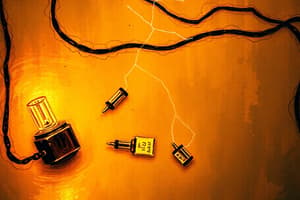Podcast
Questions and Answers
What significant invention did Alessandro Volta create that revolutionized electricity use?
What significant invention did Alessandro Volta create that revolutionized electricity use?
- Electric motor
- Electric battery (correct)
- Transformer
- Induction coil
What unit of measurement is named after Andre-Marie Ampere?
What unit of measurement is named after Andre-Marie Ampere?
- Ampere (correct)
- Volt
- Watt
- Ohm
Which of the following is NOT a basic component of a simple electrical circuit?
Which of the following is NOT a basic component of a simple electrical circuit?
- Resistor (correct)
- Connecting wires
- Lamp
- Battery
What advantage does using SI units have over other measurement systems?
What advantage does using SI units have over other measurement systems?
The publication of Alessandro Volta's work in 1800 marked the beginning of what concept in electrical engineering?
The publication of Alessandro Volta's work in 1800 marked the beginning of what concept in electrical engineering?
What is the definition of electric current?
What is the definition of electric current?
Which of the following best describes direct current (dc)?
Which of the following best describes direct current (dc)?
What does the symbol 'I' represent in the context of electric current?
What does the symbol 'I' represent in the context of electric current?
What is the relationship between voltage, work, and charge?
What is the relationship between voltage, work, and charge?
Which statement correctly describes alternating current (ac)?
Which statement correctly describes alternating current (ac)?
Flashcards
Electric Circuit
Electric Circuit
An interconnection of electrical devices used to transfer energy from one point to another.
Electric Circuit Element
Electric Circuit Element
Each individual component in an electric circuit, like a battery or a light bulb.
Alessandro Volta
Alessandro Volta
Italian physicist who invented the electric battery and capacitor.
Electric Current
Electric Current
Signup and view all the flashcards
SI Units
SI Units
Signup and view all the flashcards
Andre-Marie Ampere
Andre-Marie Ampere
Signup and view all the flashcards
Electric Current Unit
Electric Current Unit
Signup and view all the flashcards
Simple Electric Circuit Components
Simple Electric Circuit Components
Signup and view all the flashcards
Electron Charge
Electron Charge
Signup and view all the flashcards
Electric Current (I)
Electric Current (I)
Signup and view all the flashcards
Direct Current (DC)
Direct Current (DC)
Signup and view all the flashcards
Alternating Current (AC)
Alternating Current (AC)
Signup and view all the flashcards
Voltage (V)
Voltage (V)
Signup and view all the flashcards
Study Notes
Basic DC Circuit Concepts
- Alessandro Volta (1745-1827): Italian physicist who invented the electric battery, enabling continuous electric flow. Invented the capacitor.
- Andre-Marie Ampere (1775-1836): French mathematician and physicist who formulated the laws of electromagnetics. Developed a method to measure electric current. Defined electrodynamics. Unit of electric current is named after him.
- Electric Circuit: An interconnection of electrical devices (elements) used to transfer energy.
- Simple Circuit Components: Battery, lamp, and connecting wires are basic components.
- SI Units: System of units used throughout the text, utilizes prefixes based on powers of 10 to relate larger/smaller units to the basic unit.
- Charge and Current:
- Electrons have a negative charge (-).
- Protons have a positive charge (+).
- Neutrons are neutral.
- Electric current (I) is the rate of charge flow (measured in amperes).
- Direct Current (DC): Constant current flow.
- Alternating Current (AC): Sinusoidally varying current.
- Voltage: Energy required to move a unit of charge between two points. Measured in volts (V).
- Power: Rate of energy transfer or dissipation. Measured in watts (W). Power = voltage × current.
- Passive Sign Convention: Current entering a positive terminal results in positive power (absorbed); current entering negative terminal results in negative power (supplied).
- Circuit Elements: An electric circuit consists of passive and active elements.
- Passive elements (resistors, capacitors, inductors) don't generate energy.
- Active elements (generators, batteries, operational amplifiers) generate energy.
- Independent Sources: Provide a specific voltage or current that isn't dependent on other circuit variables.
- Dependent Sources: Source quantity (voltage or current) is controlled by another voltage or current in the circuit. Usually represented by diamond-shaped symbols.
- Various types: voltage-controlled voltage source (VCVS), current-controlled voltage source (CCVS), voltage-controlled current source (VCCS), and current-controlled current source (CCCS).
Problems and Examples (from provided pages)
- Problem 1: Calculate power received/delivered by a specific component in a given circuit. Data for other elements given, algebraic sum should equal zero.
- Problem 2: Calculate current drawn by a 1.5kW electric heater plugged into 120V.
- Problem 3: Calculate power absorbed by different elements within circuit (diagram provided).
- Problem 4: Determine a circuit current (I0) (diagram provided).
- Problem 5: Determine voltage (Vo) in a circuit (diagram provided).
Studying That Suits You
Use AI to generate personalized quizzes and flashcards to suit your learning preferences.




